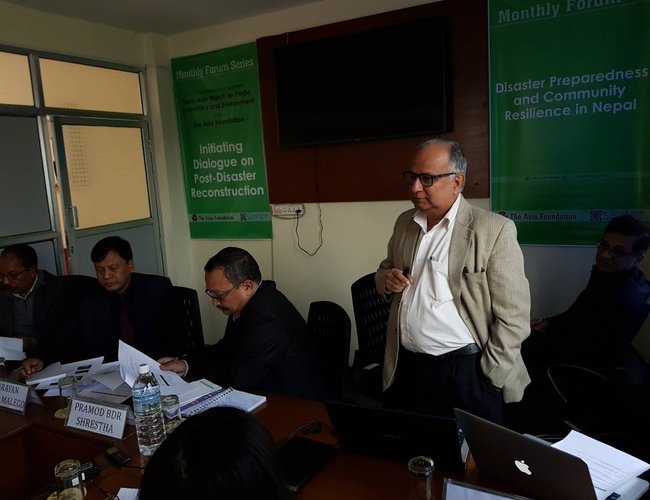
Resilience is a complex concept to define and even more complex to achieve as there are no set rules or processes that ensure it, but steps can be taken towards building a resilient family, community and ultimately country that can enhance their ability to bounce back from past disaster and be better prepared to bounce back from any future ones.
Resilience is a full-fledged concept that is not just limited to disaster preparedness or recovery. It is an interconnected process that involves improved preparedness leading to a greater degree of shock absorption at the time of disaster, with the end goal of returning the communities back to the identity and structures of the pre-disaster period. It is a continuous process that keeps on learning from past experiences. Moreover, building resilient households can lead to a resilient country with the ability to better withstand and survive any kind of hazard, be it earthquakes, floods or landslides.
Before beginning to unpack the concept of resilience and thereby trying to identify ways to moving towards a more resilient country, there is a need to understand its various components. It is an interplay of the systems (natural and human-built), agents and institutions. Natural systems have the inherent ability to regenerate themselves from shocks within a threshold. On the other hand, human-built systems like buildings, roads and dams, when affected by disasters, do not possess the ability to revert to their pre-disaster state without human interventions. Agents are the individuals, households, communities and businesses, among others, that are affected by the disaster. Not all agents in the society have equal capacity and in a highly stratified society like ours there are groups that are more vulnerable than others. They do not all have the same capacity to be better prepared for a disaster as well as bounce back from the damage to their livelihoods caused by the disaster, thereby making these groups more vulnerable. Moreover, there is a direct linkage between the systems and the livelihood of the agents, and disruptions in these systems are bound to have serious effects on the lives of the agents.
Institutions, another component in resilience building, are the governing bodies that provide the guiding policies, rules and social conventions that regulate and guide the interactions between the agents and their access to natural and human-built systems. Vulnerability exists when the agents are marginalized and do not have access to a well-conserved and managed natural system, and there are poorly built and maintained human-built systems with limited access to information and, above all, poorly regulated institutions. On the other end of the scale is a resilient community with strong institutions, access of the agents to well-conserved natural systems, well-designed and built human-built systems as well as enhanced capacity of the agents.
The earthquake of 2015 has revealed many weaknesses in our institutional and social systems when it comes to disaster preparedness and recovery. Resiliency seems to have been merely limited to a frequently used jargon in the policy as well as development communities with minimal implementation. As a multi-hazard prone country that had seen hazards prior to the 2015 earthquake, we were poorly prepared for the massive destruction to the natural and human-built systems that followed. Burdened with institutional amnesia, bureaucratic hassles, inefficient implementation, opaque and vague policies etc., the shortcomings of the existing institutions spawned their unraveling, exposing individuals and communities to unforeseeable hardships.
The widely popularized concept of ‘Build Back Better’ being used in the reconstruction and recovery phase post 2015 earthquake is one move towards building resilience but resilience cannot be achieved by just building back better infrastructures. These infrastructures need to be linked to improving the livelihoods of the communities. Resilience should be holistic and inclusive of all types of agents so as not leave any marginalized groups behind and should involve, inter alia, building capacity of the agents, diversifying livelihood activities and strengthening our institutions.
The first step towards building a resilient community is to be better prepared. Disaster risk reduction and preparedness at the household and community level which can be achieved by creating disaster risk reduction awareness, increasing the community’s access to information, formulating disaster risk reduction plans at the community level, providing training in response and rescue and creating community response teams, building community centers to be used at the time disaster, creating a stock of resources required for rescue and response, creating funds for preparedness as well as rescue and recovery, assessing the multi-hazard risk of the community and developing early warning system, etc. All these solutions seem simple and plausible and they are but there needs to be an enabling environment that can only be provided by a strong institutional structure. Communities need to be supported by their local governments in many aspects of the above-mentioned ways of disaster risk reduction. Reducing vulnerability of the marginalized group is also a responsibility of the institutions. These institutions should recognize the rights of the agents to access the available resources and information, ensure good governance in decision making through transparency in information flow as well as the maintenance of past knowledge so as to continually learn and adapt to changes as required. Resilience in no way provides certainty of completely fail-proof systems but moves the system towards one which is well prepared to absorb the shock and distress brought about by the destruction and can revert to is pre-disaster status.
The earthquake of 2015, although massively destructive, offered an opportunity for building a disaster-resilient country that is well-equipped to face any future disaster, not just earthquakes. A rather glass-half view of the disaster that disrupted the lives of million, but it seems this is the right time to talk about preparations for future shocks as we are recovering from the damages of the previous disaster. Therefore, holistic and inclusive resilience building is necessary. Reducing the vulnerabilities of the households could lead to reducing vulnerabilities of the communities and that of the whole country.

Pragati Koirala
Koirala is a Research Associate South Asia Watch on Trade, Economics and Environment (SAWTEE) Kathmandu, Nepal
- Understanding Post-Disaster Conflict
- Dec 24, 2017
- Recovery And Reconstruction: A look At The Reconstruction Expenditure
- Oct 15, 2017
- Post-quake Reconstruction: Hope Beckons After Slow Start
- Aug 27, 2017












